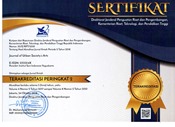Drawing Maps for Research in Creative Writing through A/r/tography
Abstract
The return of Creative Writing to the academia was intended as an answer to rigid approaches employed in the nineteenth century’s teaching of English Literature. This comeback has since brought back a new perspective in seeing body of literature as a living body but at the same time also introduced clash between dominating research paradigm in the academia. The writers who were hired to teach creative writing tended to prioritise their creative practice, while the general consensus in academia called for more theoretical-oriented research. In order to compromise, the practice-based research method was born.
Despite various justifications that creative process is the same as research inquiry, the heavier emphasis on creative works in this method still invites criticism, such as the lack of research rigour (Biggs & Büchler, 2007). New framework to balance and bridge practice and research rigour is thus needed – especially one that can accommodate the non-linear thinking trajectories in creative practices. Due to the possible non-linearity, the new research platform should not follow the reigning ‘arborescent scheme’ in the academic research tradition, but incorporate the concept of Deleuzian rhizome.
A/r/tography – developed based on the premise of art and art creation as a rhizomatic process / activity – is proposed as one of the potential practices for creative writing research. The non-linear view of a/r/tography towards arts practices suggests a rhizomatic role in the mapping of creative writing process. As it addresses and accommodates multiplicities, a/r/tography also facilitates non-native English speakers to conduct and map his journey in art creation and research inquiry. Author’s project of writing a collection of bilingual poems based on classical Javanese song cycle – Sekar Macapat – is presented to illustrate the claim.
Keywords
Full Text:
PDFReferences
Adams, Tony E., Stacy Linn Holman Jones, and Carolyn Ellis. Autoethnography. Oxford ; New York: Oxford University Press, 2015. Print.
Amorim, Antonio, and Charly Ryan. “Deleuze, Action Research and Rhizomatic Growth.” Educational Action Research 13.4 (2005): 581–594. Print.
Anderson, Benedict R. O’G. Imagined Communities: Reflections on the Origin and Spread of Nationalism. Rev. and extended ed. London ; New York: Verso, 1991. Print.
Anderson, L. “Analytic Autoethnography.” Journal of Contemporary Ethnography 35.4 (2006): 373–395. CrossRef. Web. 11 May 2017.
Andrews, Kimberly. “A House Divided: On the Future of Creative Writing.” College English 71.3 (2009): 242–255. Print.
Barrett, Estelle. “Experiential Learning in Practice as Research: Context, Method, Knowledge.” Journal of Visual Art Practice 6.2 (2007): 115–124. CrossRef. Web. 26 Feb. 2017.
Biggs, Michael, and Daniela Büchler. “Rigor and Practice-Based Research.” Design Issues 23.3 (2007): 62 – 69. Print.
Brook, Scott. “The Critiques of Practice-Led Research.” TEXT 16.2 (2012): 1 – 10. Print.
Calhoun, Craig J., and Richard Sennett, eds. Practicing Culture. London ; New York: Routledge, 2007. Print. Taking Culture Seriously.
Colman, Felicity. “Rhizome.” The Deleuze Dictionary. Edinburgh: Edinburgh Univ. Press, 2010. 232–235. Print.
Deleuze, Gilles. Anti-Oedipus: Capitalism and Schizophrenia. Minneapolis: University of Minnesota Press, 1983. Print.
---. A Thousand Plateaus: Capitalism and Schizophrenia. Minneapolis: University of Minnesota Press, 1987. Print.
Denzin, N. K. “Analytic Autoethnography, or Deja Vu All Over Again.” Journal of Contemporary Ethnography 35.4 (2006): 419–428. CrossRef. Web. 11 May 2017.
Glesne, Corine. “That Rare Feeling: Re-Presenting Research through Poetic Transcription.” Qualitative Inquiry 3.2 (1997): 202–221. Print.
Gregorious, Zelia. “Commencing the Rhizome: Towards a Minor Philosophy of Education.” Educational Philosophy and Theory 36.3 (2004): 233–253. Print.
Harper, Graeme, and Jeri Kroll, eds. Creative Writing Studies: Practice, Research and Pedagogy. Clevedon [England] ; Buffalo [NY]: Multilingual Matters, 2008. Print. New Writing Viewpoints.
Hecq, Dominique. “Beyond the Mirror: On Experential Knowing as Research Mode in Creative Writing.” TEXT 16.2 (2012): 1 – 13. Print.
Hobsbaum, Philip. “The Teaching of Creative Writing.” Teaching Creative Writing. Ed. Moira Monteith and Robert Miles. Philadelphia: Open University Press, 1992. 24 – 33. Print.
Honan, Eileen. “Writing a Rhizome: An (im)plausible Methodology.” International Journal of Qualitative Studies in Education 20.5 (2007): 531–546. CrossRef. Web. 11 Aug. 2015.
Irwin, Rita et al. “The Rhizomatic Relations of A/r/tography.” Studies in Art Education 48.1 (2006): 70–88. Print.
Kelen, Christopher. “Community in the Translation/Response Continuum: Poetry as Dialogic Play.” Collective Creativity. Amsterdam ; New York: Rodopi, 2011. 281–298. Print.
---. “Process and Product, Means and Ends, Creative Writing in Macao.” Beyond Babel: Exploring Second Language Creative Writing. Amsterdam ; New York: John Benjamins Publishing Company, 2014. 75–102. Print.
Klei, Alice van der. “Repeating the Rhizome.” SubStance 31.1 (2002): 48–55. CrossRef. Web. 25 May 2015.
Lave, Jean & Wenger, Etienne. Situated Learning: Legitimate Peripheral Participation. Cambridge University Press, 1991.
Leavy, Patricia. Method Meets Art: Arts-Based Research Practice. Second edition. New York ; London: The Guilford Press, 2015. Print.
Leggo, Carl et al. “Lingering in Liminal Spaces: A/r/tography as Living Inquiry in a Language Arts Class.” International Journal of Qualitative Studies in Education 24.2 (2011): 239–256. CrossRef. Web. 25 Mar. 2015.
---. “Research as Poetic Rumination: Twenty-Six Ways of Listening to Light.” The Journal of Educational Thought 33.2 (1999): 112–133. Print.
---. “The Curriculum of Joy: Six Poetic Ruminations.” Journal of the Canadian Association for Curriculum Studies 2.2 (2004): 27 – 43. Print.
---. “The Heart of Pedagogy: On Poetic Knowing and Living.” Teachers and Teaching 11.5 (2005): 439–455. CrossRef. Web. 25 May 2015.
Livesey, Graham. “Assemblage.” The Deleuze Dictionary. Edinburgh: Edinburgh Univ. Press, 2010. 18–19. Print.
Lorraine, Tamsin. “Lines of Flight.” The Deleuze Dictionary. Edinburgh: Edinburgh Univ. Press, 2010. 147–148. Print.
---. “Plateau.” The Deleuze Dictionary. Edinburgh: Edinburgh Univ. Press, 2010. 208–209. Print.
Magee, Paul. “Beyond Accountability ?” TEXT 16.2 (2012): 1 – 19. Print.
Mayers, Tim. “One Simple Word: From Creative Writing to Creative Writing Studies.” College English 71.3 (2009): 217 – 228. Print.
Monteith, Moira. “Creative Writing: A Historical Perspective.” Teaching Creative Writing. Ed. Moira Monteith and Robert Miles. Philadelphia: Open University Press, 1992. 10 – 23. Print.
Murray, Donald Morison. A Writer Teaches Writing. Rev. 2nd ed. Boston: Thomson/Heinle, 2004. Print.
Myers, D. G. The Elephants Teach: Creative Writing since 1880. University of Chicago Press ed. Chicago: University of Chicago Press, 2006. Print.
---. “The Rise of Creative Writing.” Journal of the History of Ideas 54.2 (1993): 277. CrossRef. Web. 15 Apr. 2017.
Prendergast, Monica, Carleton Derek Leggo, and Pauline Sameshima. Poetic Inquiry: Vibrant Voices in the Social Sciences. Rotterdam, The Netherlands; Boston: Sense Publishers, 2009. Open WorldCat. Web. 15 Mar. 2017.
Roffe, Jonathan. “Multiplicity.” The Deleuze Dictionary. Edinburgh: Edinburgh Univ. Press, 2010. 181–182. Print.
Ryan, Alyssa. “Connecting Two Research Strategies : A Hybrid Model.” TEXT 9.1 (2005): n. pag. Web. 2 Nov. 2017.
Sinner, Anita et al. “Arts-Based Educational Research Dissertations: Reviewing the Practices of New Scholars.” Canadian Journal of Education 29.4 (2006): 1223 – 1270. Print.
Semetsky, Inna. “Deleuze’s New Image of Thought, or Dewey Revisited.” Educational Philosophy and Theory 35.1 (2003): 17–30. Print.
Sennett, Richard. The Craftsman. New Haven: Yale University Press, 2008. Print.
---. The Culture of the New Capitalism. New Haven: Yale University Press, 2006. Print. The Castle Lectures in Ethics, Politics, and Economics.
Spinks, Lee. “Eternal Return.” The Deleuze Dictionary. Edinburgh: Edinburgh Univ. Press, 2010. 85–87. Print.
Springgay, S. “A/r/tography as Living Inquiry Through Art and Text.” Qualitative Inquiry 11.6 (2005): 897–912. CrossRef. Web. 25 Mar. 2015.
Springgay, Stephanie. “An Ethics Of Embodiment, Civic Engagement and A/R/Tography: Ways Of Becoming Nomadic In Art, Research And Teaching.” Educational Insight 12.2 (2008): n. pag. Web. 20 Mar. 2015.
---. Being with A/r/tography. Rotterdam: Sense Publishers, 2008. Print.
Stagoll, Cliff. “Arborescent Schema.” The Deleuze Dictionary. Edinburgh: Edinburgh Univ. Press, 2010. 14–15. Print.
---. “Becoming.” The Deleuze Dictionary. Edinburgh: Edinburgh Univ. Press, 2010. 25–27. Print.
Stewart, Robyn. “Practice vs Praxis: Constructing Models for Practitioner-Based Research.” TEXT 5.2 (2001): n. pag. Print.
---. “(Re)inventing Artists’ Research: Constructing Living Forms of Theory.” TEXT 7.2 (2003): n. pag. Print.
Sturm, Damion. “Playing With the Autoethnographical: Performing and Re-Presenting the Fan’s Voice.” Cultural Studies ↔ Critical Methodologies 15.3 (2015): 213–223. CrossRef. Web. 11 May 2017.
Vryan, K. D. “Expanding Analytic Autoethnography and Enhancing Its Potential.” Journal of Contemporary Ethnography 35.4 (2006): 405–409. CrossRef. Web. 11 May 2017.
Webb, Jen, and Donna Lee Brien. “‘Agnostic’ Thinking: Creative Writing as Practice-Led Research.” Working Papers in Arts and Design 5 (2008): n. pag. Web. 5 Mar. 2017.
Williams, James. “Immanence.” The Deleuze Dictionary. Edinburgh: Edinburgh Univ. Press, 2010. 128–131. Print.
DOI: https://doi.org/10.24821/jousa.v4i2.2158
Refbacks
- There are currently no refbacks.

This work is licensed under a Creative Commons Attribution 4.0 International License. ISSN 2355-2131 (print) | ISSN 2355-214X (online).






